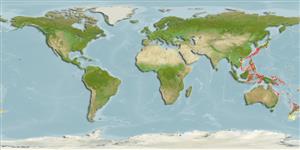Klassifizierung / Names
Namen | Synonyme | Catalog of Fishes(Gattung, Arten) | ITIS | CoL | WoRMS | Cloffa
>
Pleuronectiformes (Flatfishes) >
Cynoglossidae (Tonguefishes) > Symphurinae
Etymology: Symphurus: Greek, syn, symphysis = grown together + Greek, oura = tail (Ref. 45335); bathyspilus: From the Greek bathy meaning deep, in reference to deepwater habitat, and spilos, meaning spot, in reference to the numerous, small, reddish speckles on the blind-side body (Ref. 51120).
Environment: milieu / climate zone / depth range / distribution range
Ökologie
seewasser bathydemersal; tiefenbereich 248 - 500 m (Ref. 51120), usually 335 - 431 m (Ref. 51120). Deep-water
Western Central Pacific: Philippines and southern Indonesia.
Size / Gewicht / Alter
Maturity: Lm ? range ? - ? cm
Max length : 12.1 cm SL Männchen/unbestimmt; (Ref. 51120)
Kurzbeschreibung
Morphologie | Morphometrie
Rückenflossenweichstrahlen (insgesamt): 91-100; Afterflossenweichstrahlen: 78 - 87; Wirbelzahl: 50 - 54. Characterized by the combination of a predominant 1-2-2 pattern of interdigitation of dorsal pterygiophores and neural spines; 14 caudal-fin rays; 91-100 dorsal-fin rays; 78-87 anal-fin rays; 50-54 vertebrae, a pointed snout, black peritoneum, and distinctive features of its ocular- and blind-side coloration (in alcohol) including ocular-side background coloration uniformly bright (freshly captured) to darker reddish-brown with some specimens having a series of faint, reddish-brown, incomplete crossbands; outer surface of ocular-side opercle yellowish with reddish-brown speckles; dorsal and anal fins darker reddish-brown anteriorly, fading to a pale reddish posteriorly; blind side uniformly yellowish to straw-colored, except proximal pterygiophore regions of dorsal and anal fins with dense covering of reddish-brown speckles; both sides of dorsal, anal, and pelvic fins covered with dense concentrations of small red speckles; speckling especially dense on blind-side body in region around anus and also on both sides of pelvic fin (Ref. 51120).
Appears to feed on small fishes and crustaceans (Ref. 51120).
Life cycle and mating behavior
Geschlechtsreife | Fortpflanzung | Ablaichen | Eier | Fecundity | Larven
Krabbenhoft, T.J. and T.A. Munroe, 2003. Symphurus bathyspilus: a new cynoglossid flatfish (Pleuronectiformes: Cynoglossidae) from deepwaters of the Indo-West Pacific. Copeia 2003(4):810-817. (Ref. 51120)
IUCN Rote Liste Status (Ref. 130435)
Bedrohung für Menschen
Harmless
Nutzung durch Menschen
Mehr Information
NamenSynonymeMetabolismusRäuberÖkotoxikologieFortpflanzungGeschlechtsreifeAblaichenSpawning aggregationFecundityEierEientwicklung
Alter/GrößeWachstumLänge-GewichtLänge-LängeLängenhäufigkeitenMorphometrieMorphologieLarvenLarven Pop.Dyn.RekrutierungDichteBRUVS
ReferenzenAquakulturAquakultur ProfilZuchtlinienGenetikElectrophoresesVererbbarkeitKrankheitenVerarbeitungNutrientsMass conversion
PartnerBilderStamps, Coins Misc.LauteCiguateraGeschwindigkeitSchwimmstilKiemenoberflächeOtolithsGehirngrößeSehfähigkeit
Tools
Zusatzinformationen
Download XML
Internet Quellen
Estimates based on models
Preferred temperature (Ref.
123201): 6.9 - 13.5, mean 9.8 °C (based on 121 cells).
Phylogenetic diversity index (Ref.
82804): PD
50 = 0.5000 [Uniqueness, from 0.5 = low to 2.0 = high].
Bayesian length-weight: a=0.01445 (0.00647 - 0.03228), b=3.05 (2.85 - 3.25), in cm total length, based on LWR estimates for this (Sub)family-body shape (Ref.
93245).
Trophic level (Ref.
69278): 3.3 ±0.4 se; based on size and trophs of closest relatives
Widerstandsfähigkeit (Ref.
120179): mittel, Verdopplung der Population dauert 1,4 - 4,4 Jahre. (Assuming tmax>3).
Fishing Vulnerability (Ref.
59153): Low vulnerability (10 of 100).
